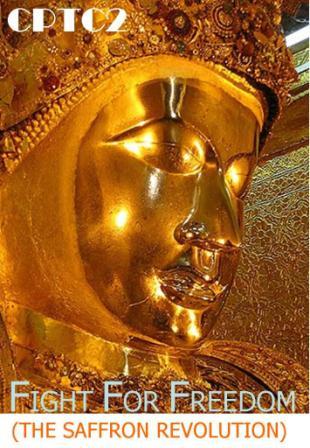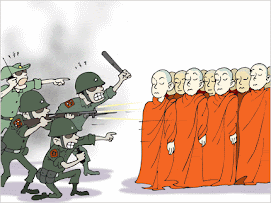Who Lost the Most in the 2007 Uprising?
By The Irrawaddy January 7, 2008
Who were the true winners and losers in the uprising now widely known as the “Saffron Revolution”? The truth is everyone involved lost—the Burmese people, the military junta and the international community.
Most Burmese people lost faith in a better future, their dreams again destroyed by the dark reality of oppression and ruthlessness.
The generals lost their chance to show the world they wished to move towards a legitimate government and gain the world’s recognition as leaders who guided Burma to true democracy. The generals might have gone down in history as men of vision, but because they stayed true to their past they will be remembered only as unenlightened villains who have the people’s blood on their hands.
The international community lost in its efforts to effect peaceful change and is now searching for new ways to move the regime toward national reconciliation—which seems farther away than ever. Asean, especially, lost its chance to turn a new page, on which it could show it understands its responsibilities within the world community.
After the brutal crackdown on Buddhist monks and peaceful protesters in Burma, it seems that virtually the entire world stands together in a perhaps unprecedented show of solidarity and sympathy.
The UN calls for the ruling generals to move towards a real dialogue with opposition groups as part of an inclusive national reconciliation process, including the establishment of a broad-based poverty alleviation commission.
The US and EU recently tightened sanctions on the military government in one more attempt to force the generals to see reason.
However, confident in the tacit support it receives from its closest neighbors, China, India and its partners in Asean, the junta has yet to show real movement in the direction of a reconciliation process. In all likelihood, even the pretences it makes towards that end will soon be scrapped and buried in the graveyard of dashed hopes.
The Burmese people are painfully conscious of how their country has lagged behind the rest of the world. Sixty years after gaining its independence, the country has failed to take its place in the world community of established nations.
The roots of Burma’s crisis lie in the generals’ ignorance and mismanagement, which have led the country into political and economic instability.
A recent example: the leader of the junta, Snr-Gen Than Shwe, declared in December that the government would achieve rice sufficiency for a projected population of 100 million.
The absurd statement shows how far Than Shwe is out of touch with reality. In October, the World Food Programme said some 5 million people in Burma did not have enough to eat. The WFP blamed severe distortions in the economy, such as the junta’s restrictions on travel and trade, for causing widespread hunger in a potential food-surplus country. About one million Burmese struggle to survive as migrant workers—whether documented or undocumented—in neighboring countries.
Than Shwe has rejected the concerns voiced by the Burmese people and the international community, including the UN. Instead, he relies on—and may even believe—the reports fed to him by Minister of Industry-1 Aung Thaung and Minister of National Planning Soe Tha, who claim annual GDP is skyrocketing into double digits.
He no doubt agrees with Information Minister Kyaw Hsan, who charged the international media with exaggerating the September uprising and harming Burma’s image. The demonstrations were “trivial,” he said—a sentiment that fell in line with the junta’s post-uprising statement: “We are in control.”
The Burmese people continue to endure the oppressive military regime led by Than Shwe, who is attempting to establish a monarchy-style rule which could lead the country into an even darker age as a failed state.
Sadly, but unavoidably, that knowledge will drive more of Burma’s suffering people to sacrifice their lives—killed, imprisoned or forced to flee the country—in the hope of creating a democratic, free and prosperous nation.
It’s the people who have lost the most, by far.
New Opposition Bulletin Published in Rangoon
By Saw Yan Naing January 7, 2008
A new opposition bulletin, Ah-yoan-thit, or “Dawn,” was published and distributed by youth members of the National League for Democracy on January 4, the anniversary of Burma’s independence.
It is the first in-country bulletin reporting on anti-regime issues and events since the closure of an earlier NLD bulletin 18 years ago.
The earlier bulletin shut down in 1990 on orders from the military government.
Ah-yoan-thit will reportedly be published bi-monthly. The NLD could not be reached for comment.
In the first issue, the bulletin carried articles about the September crackdown on peaceful protestors the closure of Maggin Monastery by the junta, detained NLD members, the distribution of VCDs critical of the junta and other events.
The bulletin reported that Ko Ko Win, who was involved in the Buddhist monk-led September protests, was killed after he was brutally beaten by security forces and riot policemen. Thet Pai Soe, who marched in the front of protesters, died from head wounds after he was shot by Burmese forces on September 26, the bulletin reported.
Meanwhile, among five members of the 88 Generation Students group who were arrested on December 19, two of them—Khin Moe Aye and Kyaw Kyaw Soe—are still being detained in Rangoon’s Insein prison. The other three members are missing, the bulletin added.
The bulletin said the hunt for activists is still going on.Prominent women activists such as Nilar Thein and Phyu Phyu Thin are still in hiding while Mie Mie and Su Su Nway are still detained by authorities, following their involvement in the September protests
Monday, January 7, 2008
Posted by
CINDY
at
8:09 PM
![]()
Subscribe to:
Post Comments (Atom)





























No comments:
Post a Comment